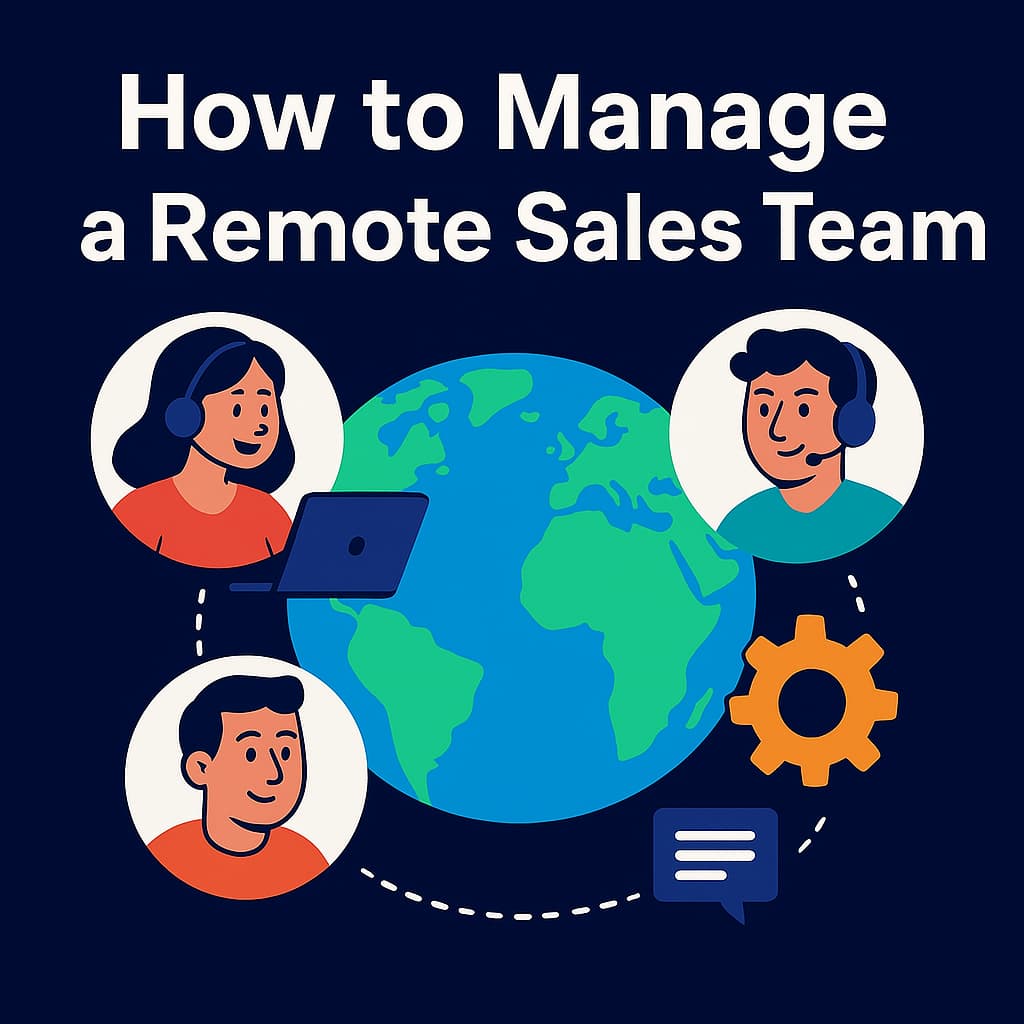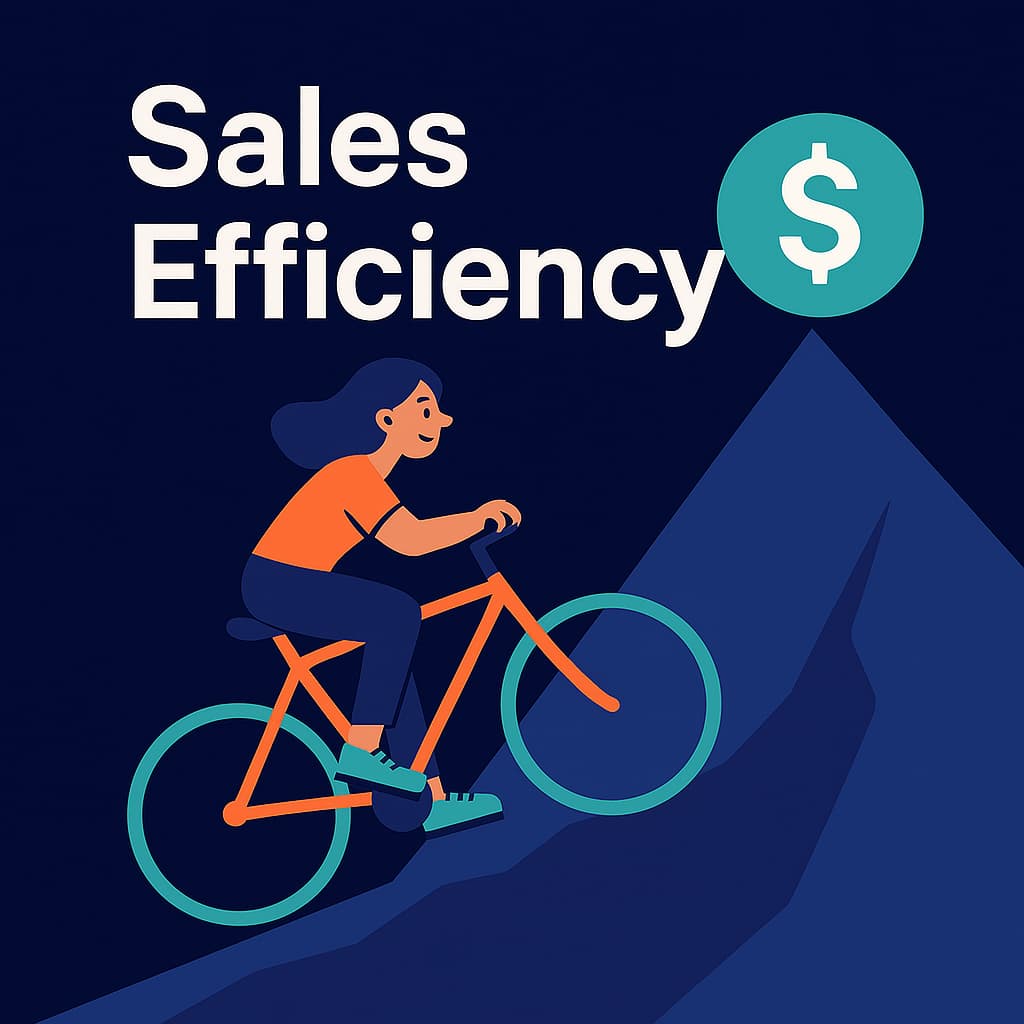
How to Manage a Remote Sales Team Effectively [2025]
Mondays now start with pings across three time zones and a pipeline that lives entirely in tabs. Buyers are deep in digital channels, and every rep on my remote sales team sells from a different location.
Leading in this new era of remote sales management isn’t about recreating the office on Zoom — it’s about building clarity, rhythm, and coaching that work anywhere.
Remote selling is the new normal. Whether your team runs hybrid or fully distributed, the principles stay the same: outcomes over hours, async first (with smart live moments), shared visibility, and data-driven coaching.
Quick reality check:
- Hybrid sales teams are 28% more likely to outperform fully remote or fully in-person ones (HubSpot, 2024).
- The Achilles’ heel of remote work is trust: only 54% of managers who oversee remote workers strongly agree they trust their teams to be productive when remote.” (Gallup, 2025).
That’s why managing a remote sales team effectively in 2025 starts with systems that turn visibility and trust into measurable performance.
The 2025 Remote Sales Reality: What the Data Tells Us
The shift to remote and hybrid models isn’t a post-pandemic anomaly — it’s the new operating system of B2B sales.
Recent data paints the picture clearly:
- 80% of all B2B sales interactions now happen virtually (HubSpot Sales Trends, 2024).
- 67% of managers say leading remote teams is harder than they expected (SalesLion, 2025).
- Yet, companies using hybrid sales motions see up to 50% faster revenue growth than single-channel organizations.
The takeaway: success in 2025 won’t come from debating remote vs. office. It comes from embedding visibility, enablement, velocity, and trust into every layer of your sales system.
Remote leadership today isn’t about removing friction — it’s about designing flow.
Why Remote Sales Management Is Different
Leading across screens replaces proximity with process and intuition with evidence.
In an office, you read the room. Remotely, you build it: dashboards instead of glances, recorded sales conversations instead of overheard coaching, and rituals that keep connection high without calendar sprawl.
Managing a remote sales team effectively means turning digital tools into extensions of your leadership.
The best sales managers use CRM dashboards, video conferencing, and collaboration tools to recreate visibility, connection, and feedback loops once found on the sales floor.
Every part of your system — sales engagement platforms, analytics, async updates — should serve one goal: helping reps sell remotely with confidence and consistency.
What changes most:
- Communication must be designed, not assumed.
- Visibility comes from shared data, not physical presence.
- Culture is a cadence, not a location.
Manager’s Cue: Great remote sales leaders don’t chase activity — they design environments where performance is visible without pressure.
The art isn’t in watching people work; it’s in making work visible by design.
The future of remote sales team management is hybrid by design.
The data is clear: remote and distributed teams outperform when leaders focus on clarity and connection.
Every sales manager today must balance digital-first buyers with human-first coaching.
Set Clear Expectations and Accountability Frameworks
Ambiguity, not distance, kills performance.
Define success in the simplest possible terms — and make it visible to everyone.
How to Manage a Remote Sales Team Day-to-Day
Day-to-day management starts with structure: outcome-based goals, real-time dashboards, and clear communication rhythms that keep everyone aligned across time zones.
Translate Strategy Into Daily Visibility
Work backward from revenue → pipeline coverage → trusted activity metrics (meetings, qualified opps, call-to-meeting conversions). Publish a dashboard everyone can see for real-time visibility. Replace “checking in” with “checking the data.”
End each week with a 90-second recap: what moved, what stalled, and what’s changing next week. Each rep can record it as a quick async video.
What Great Looks Like: every rep updates pipeline notes daily, and the manager walks into Monday’s meeting already informed.
Takeaway: Clarity isn’t control — it’s context.
When reps know the destination, they’ll find the route.
Trust, With Proof
Run one-to-ones using CRM data and call highlights, not memory.
Use deal reviews to explore why a metric moved, then agree on the next experiment.
You’ll stay close to outcomes without drifting into surveillance
Use Systems, Not Supervision
Make accountability structural, not emotional. Build clear cadences and a fixed reporting rhythm — weekly dashboards, async updates, and deal reviews powered by conversation data.
Use shared definitions (what counts as a “qualified” meeting) and a single source of truth. Consistency beats intensity.
The Remote Sales Scorecard
Use this to align on outcomes > hours. It’s a remote sales scorecard for weekly performance tracking
Operating rule: Goals live in CRM. If it isn’t there, it didn’t happen.
Manager’s Cue: Micromanagement is a tax on clarity. When visibility is built into your system, you don’t need to chase proof.
Build Effective Communication Rhythms
Most communication issues aren’t about tech — they’re about structure. Give people a rhythm that’s predictable and light.
Structuring Remote Sales Team Meetings
High-performing remote sales teams use short, consistent sales team meetings to align priorities and share wins. Use video conferencing software and tools for live collaboration, then summarize decisions asynchronously to respect focus time.
Design a cadence that scales
- Daily async (≤5 mins): 3 bullets — Focus / Blocker / One win
- Weekly team (30–45 mins):
- Pipeline by stage
- Deal deep dive
- One learning clip (or more)
- Shout-outs + actions
- weekly or Bi-weekly 1:1 (30-45 mins): 1 metric + 1 skill + 1 experiment + review 2 calls/deals for coaching
- Monthly retro (45 mins): Stop / Start / Standardize → update playbook same day.
These rituals replace hallway chatter with intentional visibility. Every touchpoint needs a purpose: alignment, coaching, or recognition. Never “because it’s Monday.”
What Great Looks Like: Use virtual meetings and video calls to keep collaboration human and transparent across time zones. Protect deep work. Meetings start on time, end early, and leave written traces.
What Average Looks Like: A meeting to plan more meetings.
Choose the Right Collaboration Tools for Remote Teams
For distributed teams, the right tools are as vital as a physical sales floor. Slack, Teams, and Zoom keep reps connected.
Balance live and async:
- Go live for decisions, coaching, and emotional moments.
- Keep updates, walkthroughs, and status changes async (short video + bullets).
- Record key meetings and post a 5-line summary so the whole team stays aligned without extra calls.
Channel Charter:
- Slack/Teams: quick Qs, help, wins (threads mandatory)
- CRM: truth for deals; no status in chat
- Async video: feedback, walkthroughs, decisions
- Email: external or approvals only
Manager’s Cue: Don’t confuse presence with productivity. Remote performance lives in cadence, not chatter. Decisions always leave a written trace.
Model it from the top: Leaders teach by example. Respect quiet hours, keep messages concise, and praise publicly — the team will copy your behavior.
Equip Your Team With the Right Tools (Lean Stack)
A connected tech stack turns chaos into clarity. From CRM to virtual meetings, every system should keep activity visible and insights centralized.
Minimum Viable Remote Stack:
- CRM: single pipeline, mandatory next step
- Call intelligence: record 100% of first calls/demos
- Engagement: auto-log sequences to CRM
- Collab: #wins, #help, #deals + async reviews
- Analytics/AI: forecast risk by stage age; AI summary at opportunity level
Manager’s Cue: More tools don’t make better reps. Better workflows do.
The best remote sales orgs run on integration discipline. Every system feeds the CRM; every insight fuels coaching. AI-driven conversation intelligence isn’t a luxury — it’s the connective tissue that makes distributed leadership scalable.
💬 “We needed a tool that wasn’t just a meeting recorder but could scale with us as our team grows and help organize knowledge better.” Head of RevOp @SEO AI on choosing Claap as their Sales Call Intelligence tool.
When a manager can search for “pricing objections” across 100 calls, coaching shifts from anecdote to evidence.
Coach and Develop a High-Performance Distributed Sales Team
In remote environments, growth isn’t ambient—it’s designed. Treat development as a product with a roadmap.
30-60-90 Hybrid Onboarding Plan — Example
- Days 1–10 (Foundation):
ICP brief, value drivers, 10 call playlists, shadow 5 live calls, pass product cert. - Days 11–60 (Execution):
30+ discovery calls, 10+ demos, two competitive teardown write-ups, 1O talk track recorded. - Days 61–90 (Autonomy):
Own 20+ opps, forecast weekly, deliver one enablement asset (email or deck module).
Every milestone is measurable and visible to the sales rep + sales manager.
Manager’s Cue: Remote onboarding is a test of structure, not charisma.
Reps don’t fail from lack of talent — they fail from unclear playbooks.
Consistent Coaching sessions on sales calls & meetings — Example
Rule: Always leave with a dated next step + recap sent in 2 hours.
Continuous coaching loops
- Weekly pipeline review (team): celebrate wins, unblock risk.
- weekly or bi-weekly 1:1 (rep): one metric + one skill, with 1 to 3 calls to review.
- Monthly enablement (recorded): new talk track, objection lab, competitor update.
💬 “I told new BDRs to watch five videos. They watched fifty. It’s shadowing on steroids.” Chief Revenue Officer, Freqens
Build Self-Sufficient Reps
- Centralize answers: playbooks, snippets, checklists
- Teach “look first, ask second” — spend time on strategy and skill, not “where’s the deck?” questions
Learning by Design:
Top-performing distributed sales orgs treat coaching like revenue ops: measurable, consistent, and public.
- Post recorded call reviews weekly
- Use shadow sessions where new hires annotate top-performer clips
- Rotate coaching ownership — senior reps run micro-trainings
What Great Looks Like: Learning is visible and ongoing; reps annotate clips, trade talk tracks, and show weekly skill deltas in scorecards.
Build Trust and Sustainable Culture
Trust decays quickly without visibility. Rebuild it with transparency and human connection.
The Psychology of Remote Trust
- Microsoft data: 85% of managers doubt remote productivity even when outputs are strong
- Over-reporting, micromanagement, and low morale often follow
- The fix isn’t more proof — it’s shared visibility
Manager’s Cue: Trust thrives where information flows. Distrust thrives where managers hoard it.
Transparency by Default:
- Open dashboards, clear targets, visible wins
- Public stories reduce the need for micromanagement
Micro-rituals that actually work
- Friday Wins (async): 4 bullets — Win / Why it worked / Who helped
- Random Coffee (15’): Auto-pair across regions monthly.
- Demo Derby (30’): One rep runs a live demo; peers tag highlights in real time.
Recognition formula: Praise the behavior, not the result. (“You isolated procurement risk early” > “Nice job.”)
Watch for silence
Remote burnout shows up as absence. If a usually vocal rep goes quiet, check capacity and context. Start with care, then adjust workload or support.
Keep purpose in view
Dashboards don’t create meaning. Stories do. Tie wins to customer outcomes and product impact; repeat them in one-to-ones and all-hands.
What Great Culture Feels Like
A rep in Berlin slows their responses. The manager notices — not from dashboards, but tone. A quick check-in reveals burnout, not disengagement.
That’s remote culture in action: empathy built on data.
Protect Work–Life Balance
Remote work can free people—or exhaust them. Make balance systemic.
Sustainable remote sales team management depends on fostering an inclusive environment where every rep feels trusted to balance autonomy with accountability.
Boundary playbook
- Core hours: 3–4 hr overlap per region.
- Quiet blocks: Two 90-min deep-work windows daily; no pings.
- Time-zone handoff: 3-line baton pass — Context / Status / Next move.
- After-hours rule: If it’s not a revenue-critical blocker today, it’s async.
Manager’s Cue: Balance isn’t about less work; it’s about sustainable rhythm.
You can’t run a marathon at sprint cadence.
Why It Matters: Remote burnout costs sales orgs twice — first in performance, then in attrition.
HubSpot’s 2024 report found 41% of in-office reps experience burnout vs. 26% remote — until boundaries blur.
The top-performing distributed teams design guardrails into their calendars: deep-work blocks, async Fridays, or recovery sprints post-quarter close.
Lead by example
Your schedule is policy. Decline late-night meetings, post summaries during work hours, and log off visibly. Permission spreads.
Leader signal: Schedule-send anything outside core hours. Your timestamp is culture.
Spot and prevent burnout
Look for shorter updates, missed rituals, and slower creativity. Start with “You okay?” before “You’re behind.” Normalize recovery days and deep-work blocks.
Document What Scales
Every undocumented process becomes a private process. That’s how misalignment starts.
💬 “Claap helped us go from chaos to structure. We finally have a repeatable sales process — and it’s working.” Head of RevOp @TenderApp
Playbook Table of Contents
- ICP & pains (by segment)
- Discovery map (questions + red flags)
- Email frameworks (openers, CTA variants)
- Call talk tracks (disco, demo, pricing)
- Mutual action plan template
- Objection library (by theme)
- Competitive snapshots (3 bullets each)
- Handoffs (MQL→SQL, AE→AM)
- SLAs & definitions (what “qualified” means)
- “What great looks like” (clips + screenshots of great calls or emails)
Maintenance rule: Update something every retro. Changelog at the top.
Manager’s Cue: Documentation isn’t bureaucracy — it’s the price of autonomy. Effective documentation creates an inclusive environment for global and distributed teams, keeping everyone aligned regardless of time zone or native language
Hire and Scale Intentionally
Scaling isn’t headcount; it’s repeatability.
Remote-DNA Screen (5 ideas of questions)
- “Write me a 6-line async update on a stuck deal.” (tests clarity)
- “Record a 90-sec product intro for a CFO.” (tests tone control)
- “Here’s a messy opportunity. What would you log to CRM?” (tests hygiene)
- “How do you plan your day across time zones?” (tests autonomy)
- “Show a template you reuse.” (tests system mindset)
Pod Structure (Example)
- EMEA Pod: 1 Lead AE, 3 AEs, 2 SDRs, 1 AM; shared RevOps support; weekly pod review + cross-pod learning clip exchange
- Retention Loop: Quarterly career map (role, skills, proof points), not just quota chat.
What Great Looks Like: Great sales managers hire for adaptability—reps who can sell remotely and hit targets across multiple time zones.
What Average Looks Like: Hiring speed > alignment. Culture dilution in 3 quarters.
Final thought
The future belongs to sales leaders who master how to manage a remote sales team through culture, cadence, and clarity—not control.
FAQs
How do you build trust with a remote sales team?
Make performance public (dashboards), keep 1:1s sacred, and coach from calls. Visibility beats surveillance every time.
What KPIs matter most?
Velocity, win rate, deal size, cycle time, call-to-meeting. Activity is input; manage it, don’t worship it.
How often should we meet?
Async daily updates; weekly team sync; bi-weekly 1:1s; monthly retro. Add ad-hoc “deal rooms” only for live decisions.
What’s the best cadence for remote sales team management?
Most remote sales teams thrive on a rhythm of daily async updates, weekly pipeline reviews, and monthly retros. This simple structure creates alignment without burnout — a proven approach for anyone learning how to manage a remote sales team effectively in 2025.
Which tools are essential?
One CRM, one collaboration layer, call intelligence, light engagement, and analytics/AI. Fewer tools → tighter behavior.
How do we prevent burnout?
Core hours, quiet blocks, explicit handoffs, schedule-send. Praise outputs, not online time.
Biggest remote management mistake?
Confusing noise with work. Design the system; then let reps execute. Great remote sales team management always balances clarity, coaching, and culture—proof that small systems beat constant supervision.


